Table of Contents
7
Tribes, Nomads and Settled Communities
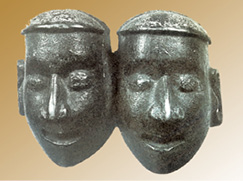
You saw in Chapters 2, 3 and 4 how kingdoms rose and fell. Even as this was happening, new arts, crafts and production activities flourished in towns and villages. Over the centuries important political, social and economic developments had taken place. But social change was not the same everywhere, because different kinds of societies evolved differently. It is important to understand how, and why, this happened.
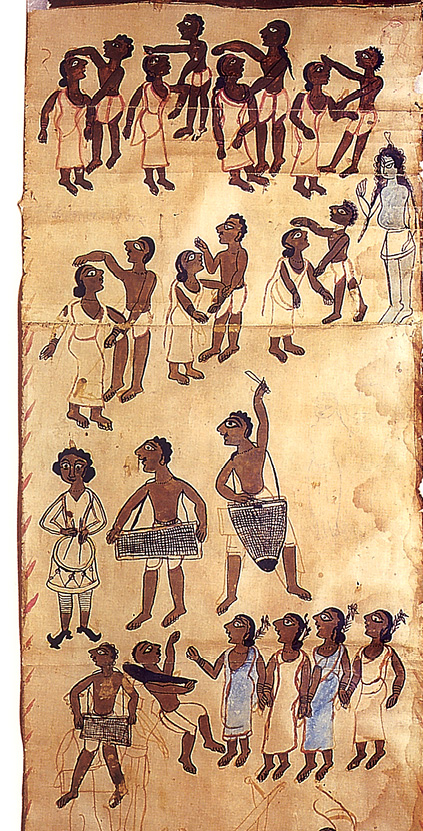
Fig. 1
Tribal dance,Santal painted scroll.
In large parts of the subcontinent, society was already divided according to the rules of varna. These rules, as prescribed by the Brahmanas, were accepted by the rulers of large kingdoms. The difference between the high and low, and between the rich and poor, increased. Under the Delhi Sultans and the Mughals, this hierarchy between social classes grew further.
Beyond Big Cities: Tribal Societies
There were, however, other kinds of societies as well. Many societies in the subcontinent did not follow the social rules and rituals prescribed by the Brahmanas. Nor were they divided into numerous unequal classes. Such societies are often called tribes.
Members of each tribe were united by kinship bonds. Many tribes obtained their livelihood from agriculture. Others were hunter-gatherers or herders. Most often they combined these activities to make full use of the natural resources of the area in which they lived. Some tribes were nomadic and moved from one place to another. A tribal group controlled land and pastures jointly, and divided these amongst households according to its own rules.
On a physical map of the subcontinent, identify the areas in which tribal people may have lived.
Many large tribes thrived in different parts of the subcontinent. They usually lived in forests, hills, deserts and places difficult to reach. Sometimes they clashed with the more powerful caste-based societies. In various ways, the tribes retained their freedom and preserved their separate culture.
But the caste-based and tribal societies also depended on each other for their diverse needs. This relationship, of conflict and dependence, gradually caused both societies to change.
Who were Tribal People?
Contemporary historians and travellers give very scanty information about tribes. A few exceptions apart, tribal people did not keep written records. But they preserved rich customs and oral traditions. These were passed down to each new generation. Present-day historians have started using such oral traditions to write tribal histories.
Tribal people were found in almost every region of the subcontinent. The area and influence of a tribe varied at different points of time. Some powerful tribes controlled large territories. In Punjab, the Khokhar tribe was very influential during the thirteenth and fourteenth centuries. Later, the Gakkhars became more important. Their chief, Kamal Khan Gakkhar, was made a noble (mansabdar) by Emperor Akbar. In Multan and Sind, the Langahs and Arghuns dominated extensive regions before they were subdued by the Mughals. The Balochis were another large and powerful tribe in the north-west. They were divided into many smaller clans under different chiefs. In the western Himalaya lived the shepherd tribe of Gaddis. The distant north-eastern part of the subcontinent too was entirely dominated by tribes – the Nagas, Ahoms and many others.
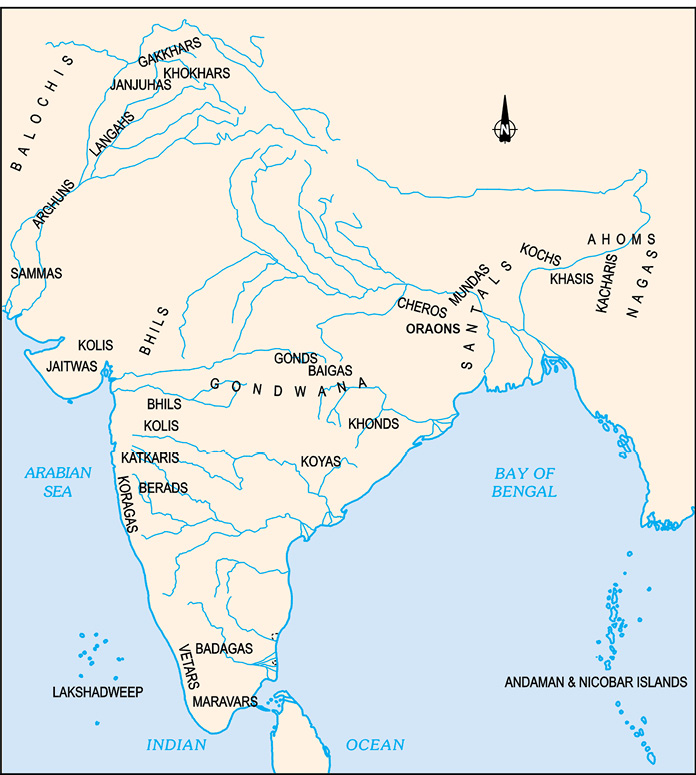
Map 1
Location of some of the major Indian tribes.
In many areas of present-day Bihar and Jharkhand, Chero chiefdoms had emerged by the twelfth century. Raja Man Singh, Akbar’s famous general, attacked and defeated the Cheros in 1591. A large amount of booty was taken from them, but they were not entirely subdued. Under Aurangzeb, Mughal forces captured many Chero fortresses and subjugated the tribe. The Mundas and Santals were among the other important tribes that lived in this region and also in Orissa and Bengal.
Clan
A clan is a group of families or households claiming descent from a common ancestor. Tribal organisation is often based on kinship or clan loyalties.
The Maharashtra highlands and Karnataka were home to Kolis, Berads and numerous others. Kolis also lived in many areas of Gujarat. Further south there were large tribal populations of Koragas, Vetars, Maravars and many others.
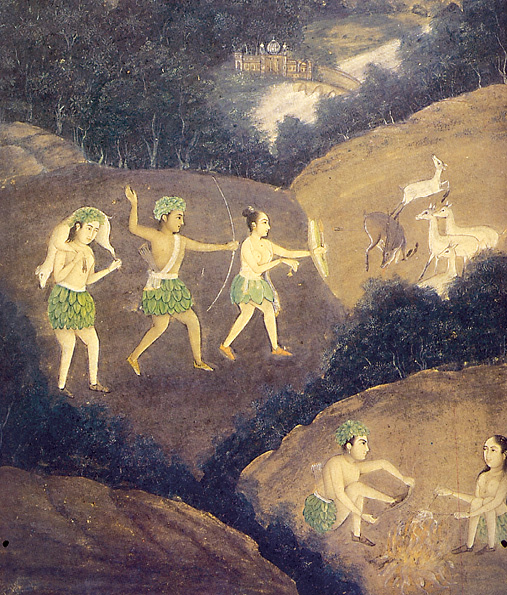
Fig. 2
Bhils hunting deer by night.
The large tribe of Bhils was spread across western and central India. By the late sixteenth century, many of them had become settled agriculturists and some even zamindars. Many Bhil clans, nevertheless, remained hunter-gatherers. The Gonds were found in great numbers across the present-day states of Chhattisgarh, Madhya Pradesh, Maharashtra and Andhra Pradesh.
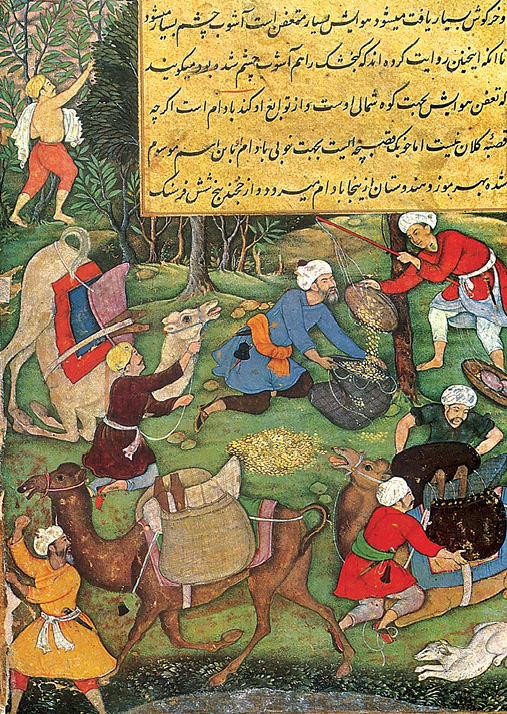
Fig.3
A chain of mobile traders connected India to the outside world. Here you see nuts being gathered and loaded on the backs of camels. Central Asian traders brought such goods to India and the Banjaras and other traders carried these to local markets.
How Nomads and Mobile People Lived
Nomadic pastoralists moved over long distances with their animals. They lived on milk and other pastoral products. They also exchanged wool, ghee, etc., with settled agriculturists for grain, cloth, utensils and other products. They bought and sold these goods as they moved from one place to another, transporting them on their animals.
Nomads and itinerant groups
Nomads are wandering people. Many of them are pastoralists who roam from one pasture to another with their flocks and herds. Similarly, itinerant groups, such as craftspersons, pedlars and entertainers travel from place to place practising their different occupations.
Both nomads and itinerant groups often visit the same places every year.
The Banjaras were the most important trader-nomads. Their caravan was called tanda. Sultan Alauddin Khalji (Chapter 3) used the Banjaras to transport grain to the city markets. Emperor Jahangir wrote in his memoirs that the Banjaras carried grain on their bullocks from different areas and sold it in towns. They transported food grain for the Mughal army during military campaigns. With a large army there could be 100,000 bullocks carrying grain.
The Banjaras
Peter Mundy, an English trader who came to India during the early seventeenth century, has described the Banjaras:
In the morning we met a tanda of Banjaras with14,000 oxen. They were all laden with grains such as wheat and rice ... These Banjaras carry their household – wives and children – along with them. One tanda consists of many families. Their way of life is similar to that of carriers who continuously travel from place to place. They own their oxen. They are sometimes hired by merchants, but most commonly they are themselves merchants. They buy grain where it is cheaply available and carry it to places where it is dearer. From there, they again reload their oxen with anything that can be profitably sold in other places … In a tanda there may be as many as 6 or 7 hundred persons … They do not travel more than 6 or 7 miles a day – that, too, in the cool weather. After unloading their oxen, they turn them free to graze as there is enough land here, and no one there to forbid them.
Find out how grain is transported from villages to cities at present. In what ways is this similar to or different from the ways in which the Banjaras functioned?
Many pastoral tribes reared and sold animals, such as cattle and horses, to the prosperous people. Different castes of petty pedlars also travelled from village to village. They made and sold wares such as ropes, reeds, straw matting and coarse sacks. Sometimes mendicants acted as wandering merchants. There were castes of entertainers who performed in different towns and villages for their livelihood.
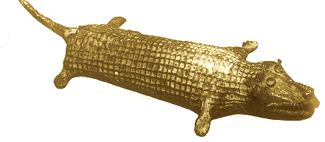
Fig. 4
Bronze crocodile, Kutiya Kond tribe, Orissa.
Changing Society: New Castes and Hierarchies
As the economy and the needs of society grew, people with new skills were required. Smaller castes, or jatis, emerged within varnas. For example, new castes appeared amongst the Brahmanas. On the other hand, many tribes and social groups were taken into caste-based society and given the status of jatis. Specialised artisans – smiths, carpenters and masons – were also recognised as separate jatis by the Brahmanas. Jatis, rather than varna, became the basis for organising society.
Deliberations on jati
A twelfth-century inscription from Uyyakondan Udaiyar, in Tiruchirapalli taluka (in present-day Tamil Nadu), describes the deliberations in a sabha (Chapter 2) of Brahmanas.
They deliberated on the status of a group known as rathakaras(literally, chariot makers). They laid down their occupations, which were to include architecture, building coaches and chariots, erecting gateways for temples with images in them, preparing wooden equipment used to perform sacrifices, building mandapas, making jewels for the king.
Among the Kshatriyas, new Rajput clans became powerful by the eleventh and twelfth centuries. They belonged to different lineages, such as Hunas, Chandelas, Chalukyas and others. Some of these, too, had been tribes earlier. Many of these clans came to be regarded as Rajputs. They gradually replaced the older rulers, especially in agricultural areas. Here a developed society was emerging, and rulers used their wealth to create powerful states.
The rise of Rajput clans to the position of rulers set an example for the tribal people to follow. Gradually, with the support of the Brahmanas, many tribes became part of the caste system. But only the leading tribal families could join the ruling class. A large majority joined the lower jatis of caste society. On the other hand, many dominant tribes of Punjab, Sind and the North-West Frontier had adopted Islam quite early. They continued to reject the caste system. The unequal social order, prescribed by orthodox Hinduism, was not widely accepted in these areas.
The emergence of states is closely related to social change amongst tribal people. Two examples of this important part of our history are described below.
A Closer Look
The Gonds
The Gonds lived in a vast forested region called Gondwana – or “country inhabited by Gonds”. They practised shifting cultivation. The large Gond tribe was further divided into many smaller clans. Each clan had its own raja or rai. About the time that the power of the Delhi Sultans was declining, a few large Gond kingdoms were beginning to dominate the smaller Gond chiefs. The Akbar Nama, a history of Akbar’s reign, mentions the Gond kingdom of Garha Katanga that had 70,000 villages.
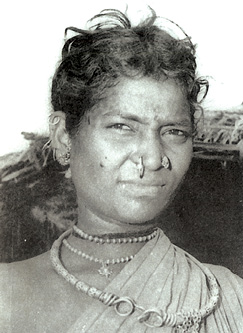
Fig. 5
A Gond woman.
Shifting cultivation
Trees and bushes in a forest area are first cut and burnt. The crop is sown in the ashes. When this land loses its fertility, another plot of land is cleared and planted in the same way.
The administrative system of these kingdoms was becoming centralised. The kingdom was divided into garhs. Each garh was controlled by a particular Gond clan. This was further divided into units of 84 villages called chaurasi. The chaurasi was subdivided into barhots which were made up of 12 villages each.
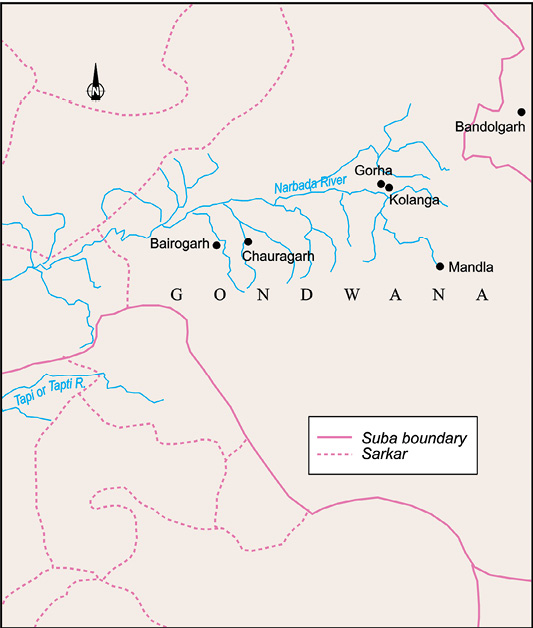
Map 2
Gondwana.
The emergence of large states changed the nature of Gond society. Their basically equal society gradually got divided into unequal social classes. Brahmanas received land grants from the Gond rajas and became more influential. The Gond chiefs now wished to be recognised as Rajputs. So, Aman Das, the Gond raja of Garha Katanga, assumed the title of Sangram Shah. His son, Dalpat, married princess Durgawati, the daughter of Salbahan, the Chandel Rajput raja of Mahoba.
Dalpat, however, died early. Rani Durgawati was very capable, and started ruling on behalf of her five-year-old son, Bir Narain. Under her, the kingdom became even more extensive. In 1565, the Mughal forces under Asaf Khan attacked Garha Katanga. A strong resistance was put up by Rani Durgawati. She was defeated and preferred to die rather than surrender. Her son, too, died fighting soon after.
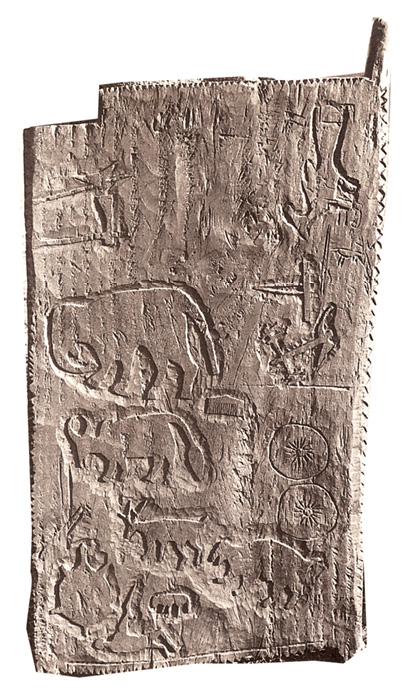
Fig. 6
A carved door. Gond tribe, Bastar area, Madhya Pradesh.
Garha Katanga was a rich state. It earned much wealth by trapping and exporting wild elephants to other kingdoms. When the Mughals defeated the Gonds, they captured a huge booty of precious coins and elephants. They annexed part of the kingdom and granted the rest to Chandra Shah, an uncle of Bir Narain. Despite the fall of Garha Katanga, the Gond kingdoms survived for some time. However, they became much weaker and later struggled unsuccessfully against the stronger Bundelas and Marathas.
Discuss why the Mughals were interested in the land of the Gonds.
The Ahoms
The Ahoms migrated to the Brahmaputra valley from present-day Myanmar in the thirteenth century. They created a new state by suppressing the older political system of the bhuiyans (landlords). During the sixteenth century, they annexed the kingdoms of the Chhutiyas (1523) and of Koch-Hajo (1581) and subjugated many other tribes. The Ahoms built a large state, and for this they used firearms as early as the 1530s. By the 1660s they could even make high- quality gunpowder and cannons.
However, the Ahoms faced many invasions from the south-west. In 1662, the Mughals under Mir Jumla attacked the Ahom kingdom. Despite their brave defence, the Ahoms were defeated. But direct Mughal control over the region could not last long.
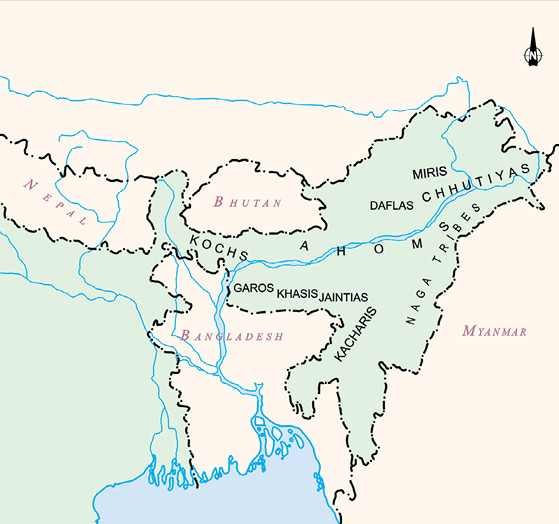
Map 3
Tribes of eastern India.
The Ahom state depended upon forced labour. Those forced to work for the state were called paiks. A census of the population was taken. Each village had to send a number of paiks by rotation. People from heavily populated areas were shifted to less populated places. Ahom clans were thus broken up. By the first half of the seventeenth century the administration became quite centralised.
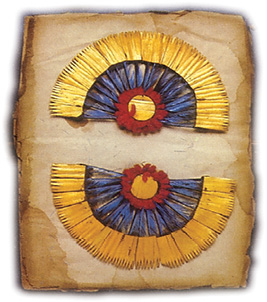
Fig. 7
Ear ornaments, Koboi Naga tribe, Manipur.
Almost all adult males served in the army during war. At other times, they were engaged in building dams, irrigation systems and other public works. The Ahoms also introduced new methods of rice cultivation.
Ahom society was divided into clans or khels. There were very few castes of artisans, so artisans in the Ahom areas came from the adjoining kingdoms. A khel often controlled several villages. The peasant was given land by his village community. Even the king could not take it away without the community’s consent.
Originally, the Ahoms worshipped their own tribal gods. During the first half of the seventeenth century, however, the influence of Brahmanas increased. Temples and Brahmanas were granted land by the king. In the reign of Sib Singh (1714-1744), Hinduism became the predominant religion. But the Ahom kings did not completely give up their traditional beliefs after adopting Hinduism.
Why do you think the Mughals tried to conquer the land of the Ahoms?
Ahom society was very sophisticated. Poets and scholars were given land grants. Theatre was encouraged. Important works of Sanskrit were translated into the local language. Historical works, known as buranjis, were also written – first in the Ahom language and then in Assamese.
Conclusion
Considerable social change took place in the subcontinent during the period we have been examining. Varna-based society and tribal people constantly interacted with each other. This interaction caused both kinds of societies to adapt and change. There were many different tribes and they took up diverse livelihoods. Over a period of time, many of them merged with caste-based society. Others, however, rejected both the caste system and orthodox Hinduism. Some tribes established extensive states with well-organised systems of administration. They thus became politically powerful. This brought them into conflict with larger and more complex kingdoms and empires.
ELSEWHERE
The Mongols
Find Mongolia in your atlas. The best-known pastoral and hunter-gatherer tribe in history were the Mongols. They inhabited the grasslands (steppes) of Central Asia and the forested areas further north. By 1206 Genghis Khan had united the Mongol and Turkish tribes into a powerful military force. At the time of his death (1227) he was the ruler of extensive territories. His successors created a vast empire. At different points of time, it included parts of Russia, Eastern Europe and also China and much of West Asia. The Mongols had well-organised military and administrative systems. These were based on the support of different ethnic and religious groups.
 Imagine
ImagineKEYWORDS
varna
jati
tanda
garh
chaurasi
barhot
bhuiyans
paik
khel
buranji
census
Map 3
Tribes of eastern India.
Let’s recall
1. Match the following:
| garh | khel |
| tanda | chaurasi |
| labourer | caravan |
| clan | Garha Katanga |
| Sib Singh | Ahom state |
| Durgawati | paik |
2. Fill in the blanks:
(a) The new castes emerging within varnas were called ____________.
(b) _____________ were historical works written by the Ahoms.
(c) The ____________ mentions that Garha Katanga had 70,000 villages.
(d) As tribal states became bigger and stronger, they gave land grants to _________ and ________.
3. State whether true or false:
(a) Tribal societies had rich oral traditions.
(b) There were no tribal communities in the north- western part of the subcontinent.
(c) The chaurasi in Gond states contained several cities.
(d) The Bhils lived in the north-eastern part of the subcontinent.
4. What kinds of exchanges took place between nomadic pastoralists and settled agriculturists?
Let’s understand
5. How was the administration of the Ahom state organised?
6. What changes took place in varna-based society?
7. How did tribal societies change after being organised into a state?
Let’s discuss
8. Were the Banjaras important for the economy?
9. In what ways was the history of the Gonds different from that of the Ahoms? Were there any similarities?
Let’s do
10. Plot the location of the tribes mentioned in this chapter on a map. For any two, discuss whether their mode of livelihood was suited to the geography and the environment of the area where they lived.
11. Find out about present-day government policies towards tribal populations and organise a discussion about these.
12. Find out more about present-day nomadic pastoral groups in the subcontinent. What animals do they keep? Which are the areas frequented by these groups?
